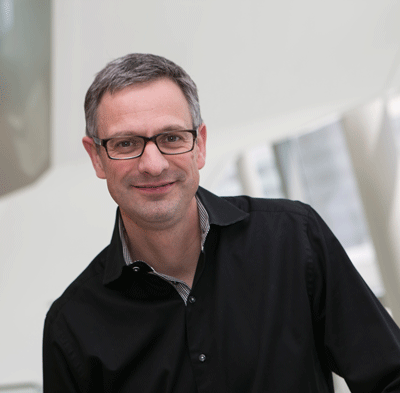A multidisciplinary team at UMass Medical School led by Job Dekker, PhD, has unraveled how chromosomes are packaged into their iconic X-shape during cell division. Packaging the genome inside mitotic chromosomes is critical to the faithful transmission of DNA from parent to daughter cells; these findings shed new light on the inner workings of cell division and may provide novel targets for potential cancer treatments.
“Cancer cells are experts at dividing. They do it well, and they do it very fast,” said Dr. Dekker, Howard Hughes Medical Institute Investigator, the Joseph J. Byrne Chair in Biomedical Research, professor of biochemistry & molecular pharmacology and co-director of the Program in Systems Biology at UMMS. “Many cancer therapies take advantage of this fact and attack dividing cells specifically in the hopes of eliminating the cancer. The more we understand about how this process works, the more ways we have to throw a wrench into this machine and disrupt this process.”
 |
|
| Job Dekker, PhD | |
| video provided by the Dekker lab |
Since chromosomes were first observed by microscope inside dividing cells more than 100 years ago, scientists have puzzled over how chromosomes received their canonical “X” shape during cell division, the process called ‘mitosis.’ Typically seen only as a diffuse mass when the cell is going about its day-to-day business, chromosomes become tightly packed into very distinctive X-shaped rods during cell division. This tight packaging helps ensure that each of the two cells post-division receives an identical copy of the genome. After the cells have divided, the genome is unpackaged again. How this fundamental process of packing and unpacking happens has long puzzled scientists.
Now, a team of researchers led by Dekker, Leonid Mirny, PhD, at the Massachusetts Institute of Technology, and Bill Earnshaw, PhD, at the University of Edinburgh, have used biochemical and imaging technologies, combined with sophisticated mathematical analysis, to unravel this mystery. The results are published today in the journal Science.
In order to capture images of the chromosome as they were being packaged, the interdisciplinary team used cells that all go through the process of mitosis simultaneously so that at different stages of the process chromosome packaging could be determined by direct microscopic observations and a genomic technology called ‘Hi-C’, a chromosome conformation capture technique developed in 2009 by Dekker to visualize the three-dimensional structure of the genome in detail. The biochemical technique determines how DNA segments interact and are linked to one another. The result, akin to a molecular microscope, can be used to detect physical interactions between DNA segments. The more interactions between segments, the more closely associated in space they are, because of the way that chromosomes fold. The Hi-C data can then be used to analyze, map and model the structure and organization of chromosomes inside cells.
The entire process of packaging the genome during mitosis takes only ten to 15 minutes. “We stopped mitosis at 1 minute, 2 minutes, 5 minutes and so forth,” said Johan H. Gibcus, PhD, instructor in biochemistry & molecular pharmacology at UMMS. “Using imaging and Hi-C data, we were able to model what the chromosome looked like at specific times while it was being packaged for division. Combing these models was like putting together a stop motion animation of the genome as it gets packaged.”
Dekker and colleagues found that as cells divide, strands of genetic material are folded to form a series of complexly compacted loops. These loops project out from a helix-shaped central axis, like steps along a spiral staircase.
First, a protein complex, known as condensin II, works as a molecular machine to grab the genome and form large loops of DNA and anchor them to a central spiraling axis that runs along the center of the rod-shaped chromosome. As these large loops are formed, over and over again, the chromosomes become shorter and wider. A related protein complex, condensin I, then acts to pinch smaller loops within these larger loops, enabling the genetic material to be further compacted in preparation for cell division. As this happens, the loops become helically distributed around a central spiraling axis of the chromosome, allowing it to become even shorter.
This combination of a helical axis and projecting loops of DNA packs the chromosomes by a factor of 10,000, causing the genetic material to fold into the familiar X-shaped rods.
“The beauty of this finding is that it unifies a number of previous observations that many thought were incongruent with each other,” said Dekker. Observational data supported the idea that the DNA within the chromosomes was coiled in some manner. You could clearly see this under the microscope, Dekker explained. At the same time, biochemical experiments performed by Dekker and others supported the theory that chromosomes were organized into loops during mitosis.
“People didn’t know how both these things could be true,” said Dekker. “What we see here is that by organizing itself in loops around a helically rotating axis, the genome can be packaged very quickly and reproducibly over and over again.”
The next step for Dekker and colleagues is to study the mechanisms responsible for unpacking chromosomes after division has successfully take place.
Related stories on UMassMedNow:
STAT: UMMS study of 3D genome may reveal ‘hidden world of folding diseases’
Dekker Lab re-imagines how genomes are assembled
Dekker, colleagues at Curie Institute untangle Barr body of inactive X chromosome
Center for 3D Structure and Physics of the Genome established at UMMS
Mapping the tightly packed world of the genomedspot